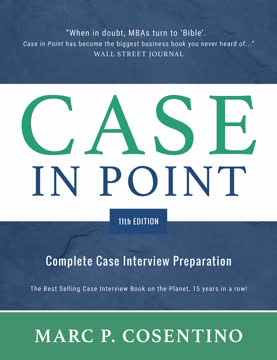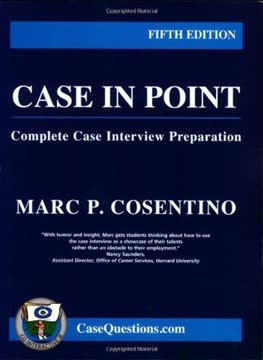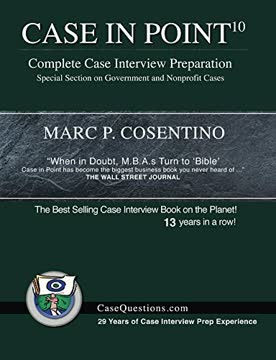Key Takeaways
1. Master the Case Interview Structure for Consulting Success
"Case interviews given by consulting firms, as well as by a growing number of companies in various industries, have become increasingly complex."
Understand the format. Case interviews typically last 20-40 minutes and simulate real consulting engagements. They test your ability to:
- Synthesize large amounts of information
- Structure an approach to a business problem
- Hypothesize logically and creatively
Follow the key steps:
- Summarize the question
- Verify objectives
- Ask clarifying questions
- Label the case and lay out your structure
- State your hypothesis
Demonstrate key skills:
- Confident, easy demeanor
- Strong communication
- Insightful questioning
- Effective organization of information
- Business sense and creativity
2. Develop a Hypothesis-Driven Approach to Problem-Solving
"Consulting firms – and only consulting firms – care about a hypothesis. They would like you to state a hypothesis within the first few minutes of the case, usually after you walk them through your structure."
State an initial hypothesis. Within the first few minutes of the case, after laying out your structure, propose an initial answer or direction. This shows:
- Structured thinking
- Ability to synthesize information quickly
- Confidence in decision-making
Benefits of hypothesis-driven thinking:
- Helps ask the right questions
- Makes analysis more linear
- Forces focus on provable/disprovable issues
- Defines a clear starting point
Refine as you go. Be prepared to update your hypothesis as you gather more information throughout the case. This demonstrates:
- Adaptability
- Active listening
- Continuous problem-solving
3. Enhance Quantitative Skills and Market Sizing Abilities
"There will be math! There are three kinds of people in the world, those good at math and those not so good. Wait, what?"
Develop mental math skills. Practice quick calculations without a calculator, focusing on:
- Percentages
- ROI
- Breakeven analysis
- Weighted averages
- Net present value
- Large number multiplication/division
Master market sizing techniques:
- Population-based questions
- Household-based questions
- Worldwide extrapolation
Key tips:
- Use round numbers for easier calculations
- Explain your thought process out loud
- Verify assumptions with the interviewer
- Double-check results for reasonableness
4. Craft Compelling Recommendations and Summaries
"If you can end the case with the interviewer feeling like a client, it doesn't get much better than that."
Structure your recommendation:
- Lead with a clear yes/no decision
- State 2-3 supporting reasons
- Outline key risks and how to mitigate them
- Propose next steps (short-term and long-term)
Effective summary techniques:
- Keep it concise (30-90 seconds)
- Recap the problem statement
- Highlight 2-3 main points/insights
- Reiterate your recommendation confidently
Use visual aids:
- Create a "final slide" summarizing key points
- Turn your notes toward the interviewer
- Walk through your analysis step-by-step
5. Navigate Different Types of Case Questions with Confidence
"Case questions generally fall into one of three major categories: market-sizing questions, factor questions, and business case questions."
Market-sizing questions:
- Use logical assumptions and simple math
- Break down into smaller, manageable segments
- Consider population, households, or worldwide extrapolation
Factor questions:
- Identify key issues influencing a situation
- Prioritize factors based on impact
- Provide a structured response (e.g., internal vs. external factors)
Business case questions:
- Typically fall into categories like:
- Profit and loss analysis
- Entering new markets
- Pricing strategies
- Growth and increasing sales
- Apply appropriate frameworks based on the specific scenario
6. Leverage the Ivy Case System for Structured Thinking
"The Ivy Case System is a two-part system made up of five easy steps to get you going and four popular case scenarios, each with a collection of ideas and questions that will help you structure the remainder of your response."
Five initial steps:
- Summarize the question
- Verify the objective(s)
- Ask clarifying questions
- Label the case and lay out your structure
- State your hypothesis
Four key scenarios:
- Profit and loss
- Entering a new market
- Pricing
- Growth and increasing sales
Benefits:
- Provides a quick start to avoid awkward pauses
- Ensures a logical and cohesive response
- Adaptable to various case types
- Helps identify relevant information and questions
7. Practice Extensively with Diverse Case Scenarios
"The best way to prepare is to hunker down and (a) read this book – and don't skip any pages; (b) attend all case question workshops sponsored by consulting firms or your career services office; (c) practice with your econ professor, roommates, friends, and anyone you know who has worked or is currently working in consulting."
Engage in various practice methods:
- Solo case reading and analysis
- Partner case practice
- Group case workshops
- Mock interviews with experienced professionals
Utilize diverse case types:
- Profit and loss scenarios
- Market entry strategies
- Pricing decisions
- Growth and sales improvement
- Mergers and acquisitions
Create a case journal:
- Record key learnings from each case
- Note creative solutions and frameworks
- Review regularly to reinforce concepts
8. Cultivate Essential Soft Skills for Consulting Interviews
"To nail a case interview, you need to know both how to prepare and how to perform."
Develop crucial soft skills:
- Confident communication
- Active listening
- Teamwork and collaboration
- Adaptability and quick thinking
- Professional demeanor
Master the "airport test":
- Demonstrate likability and interesting personality
- Show you can work well with others in stressful situations
- Prove you can represent the firm well in front of clients
Handle challenging situations:
- Remain composed when pushed or challenged
- Defend your position without becoming defensive
- Admit when you're wrong and adjust your thinking
9. Understand Industry Trends and Economic Factors
"Make sure that you write everything down; it will give you someplace to go if you get stuck."
Stay informed on current events:
- Follow major business publications (e.g., Wall Street Journal, Financial Times)
- Understand key economic indicators (e.g., GDP growth, unemployment rates)
- Be aware of industry-specific trends and disruptions
Incorporate external factors in your analysis:
- Consider the impact of economic conditions on the case
- Discuss relevant industry trends and their implications
- Demonstrate awareness of global market dynamics
Use this knowledge to:
- Frame the economic environment of the case
- Make more informed assumptions
- Predict potential challenges and opportunities
10. Prepare for Specific Firm Interviews and Formats
"Over the last couple of years, more and more firms have turned to written cases; particularly in the second and third rounds."
Research firm-specific practices:
- Understand different interview formats (e.g., written cases, group cases, online assessments)
- Familiarize yourself with firm-specific frameworks or methodologies
- Practice with cases tailored to each firm's style
Prepare for various formats:
- Written cases: Practice time management and concise writing
- Group cases: Develop teamwork and leadership skills
- Online assessments: Familiarize yourself with digital tools and timed exercises
Adapt your approach:
- Tailor your preparation to each firm's culture and values
- Be ready to discuss why you're interested in that specific firm
- Prepare thoughtful questions about the firm and its work
Last updated:
FAQ
1. What is Case in Point 11: Complete Case Interview Preparation by Marc P. Cosentino about?
- Comprehensive case interview guide: The book is a detailed manual for preparing for consulting case interviews, covering everything from interview structure to advanced case practice.
- Ivy Case System introduction: It introduces the Ivy Case System™, a structured, hypothesis-driven approach to tackling case interviews logically and efficiently.
- Realistic consulting simulation: The book explains how case interviews mimic real consulting work, requiring data analysis, structured thinking, and clear recommendations under time pressure.
- Practical examples and advice: It includes numerous real-world practice cases and actionable strategies for both case and behavioral interview components.
2. Why should I read Case in Point 11 by Marc P. Cosentino for consulting interview preparation?
- Proven and trusted resource: Called the “MBA Bible” by The Wall Street Journal, it has been the best-selling case prep book for over fifteen years and is trusted by more than 150,000 students.
- Up-to-date content: The 11th edition reflects evolving interview trends, including new case types, updated frameworks, and insights into digital interview formats.
- Actionable strategies: The book offers practical advice for handling different interview formats, answering behavioral questions, and mastering case math.
- Extensive practice material: It provides a wide range of practice cases, partner exercises, and detailed dialogues to build confidence and problem-solving skills.
3. What are the key takeaways from Case in Point 11 by Marc P. Cosentino?
- Structured problem-solving: The Ivy Case System™ helps candidates break down complex cases into manageable steps, ensuring a logical and organized approach.
- Importance of communication: The book emphasizes clear, confident communication and the ability to defend recommendations without being defensive.
- Practice and preparation: Repetition, reflection, and live practice cases are essential for building fluency and confidence in interviews.
- Adaptability and mindset: Staying calm under pressure, being coachable, and maintaining a positive self-image are critical for success.
4. What is the Ivy Case System™ in Case in Point 11 and how does it work?
- Five initial steps: The system starts with summarizing the question, verifying objectives, asking clarifying questions, labeling the case, and stating a hypothesis.
- Four key case scenarios: Most cases are categorized into profit and loss, entering a new market, pricing, and growth/increasing sales, each with tailored structures.
- Hypothesis-driven approach: Candidates are encouraged to state a hypothesis early, focusing their analysis and making the case more linear and easier to follow.
- Integration of frameworks and math: The system combines business frameworks with quantitative analysis to support recommendations with evidence.
5. What types of case questions are covered in Case in Point 11 by Marc P. Cosentino?
- Market-sizing questions: These involve estimating the size of a market or segment using logical assumptions and basic math.
- Factor questions: Candidates are asked to identify and prioritize key factors influencing a business issue, demonstrating broad business understanding.
- Business case questions: These are detailed, often interviewer- or interviewee-driven, requiring structured analysis, quantitative skills, and creative recommendations.
- Specialized cases: The book also covers mergers and acquisitions, revenue growth, cost reduction, and market entry scenarios.
6. How does Case in Point 11 by Marc P. Cosentino recommend handling math and calculations in case interviews?
- No calculator allowed: Candidates must perform mental math or write calculations by hand, clearly demonstrating their thought process.
- Estimation and rounding: The book encourages rounding numbers and estimating percentages to simplify calculations and save time.
- Practice essential formulas: Mastery of business math formulas like breakeven, ROI, profit margin, and CAGR is emphasized for quantitative confidence.
- Logical sense-checking: Always check if answers make sense in context, and walk the interviewer through calculations step by step.
7. What advice does Marc P. Cosentino give for answering behavioral and fit questions in Case in Point 11?
- Bullet-point preparation: Prepare bullet points for common questions to sound natural and authentic, rather than memorizing scripts.
- Memorable storytelling: Use unique, memorable stories to stand out, such as being “the windsurfer” or having a distinctive label.
- Honesty and reflection: Admit failures honestly, focus on lessons learned, and avoid personal or academic failures that may make interviewers uncomfortable.
- Demonstrate leadership and teamwork: Highlight experiences that showcase leadership, persuasion, and motivation for consulting.
8. What are the key components of the consulting interview process described in Case in Point 11 by Marc P. Cosentino?
- Personal experience and fit: Interviews begin with questions about your background, leadership, teamwork, and motivation for consulting.
- Case questions: The core involves solving business problems through structured case questions, testing analytical and communication skills.
- Final questions and interaction: Candidates are expected to ask insightful questions at the end, demonstrating research and genuine interest in the firm.
- Handling challenges: The process includes defending your answers professionally and adapting to interviewer pushback.
9. What are some notable practice cases and exercises included in Case in Point 11 by Marc P. Cosentino?
- Flatline: A medical device company explores market penetration and pricing strategies due to flat profits.
- Blade to Blade: A lawn mower manufacturer considers acquiring an engine supplier after a supply chain disruption.
- Disposable Revenues: A disposable goods company analyzes declining sales and product mix shifts.
- Jamaican Battery Enterprise: A battery company evaluates market entry and tariff impacts in Cuba.
- TedEx and more: Cases cover customer service, lost package costs, and other real-world business challenges, with detailed interviewer-student dialogues.
10. How does Case in Point 11 by Marc P. Cosentino recommend structuring answers and notes during a case interview?
- Landscape format and graph paper: Organize notes with clear sections for questions, structure, and data; graph paper helps align numbers.
- Final slide or summary chart: Create a summary chart during the case to organize key numbers and recommendations for easy communication.
- Logical flow: Start by restating the problem, clarifying objectives, and laying out a structured approach before analysis.
- Quantify and summarize: Walk the interviewer through calculations and end with a concise summary of findings and recommendations.
11. What are common pitfalls in case interviews according to Case in Point 11 by Marc P. Cosentino?
- Ignoring external factors: Many candidates overlook macroeconomic or industry trends that affect the client’s situation.
- Weak math skills: Struggling with mental math or unclear calculations can undermine your case performance.
- Lack of structure: Jumping into analysis without a clear framework or failing to summarize confuses interviewers and weakens your case.
- Defensiveness under pressure: Failing to handle challenges professionally or becoming defensive can hurt your impression.
12. What are the best quotes and memorable insights from Case in Point 11 by Marc P. Cosentino, and what do they mean?
- On mindset: “It’s not whether you are right or wrong, it’s how you present yourself, your information, and your thinking.” This highlights the importance of communication and presence.
- On preparation: “No athlete you ever admired went out on the playing field without warming up. You need to do the same thing.” Preparation and practice are essential for success.
- On creativity: The book encourages thinking beyond standard answers, such as proposing innovative solutions or unconventional strategies.
- On confidence: “It’s easy to forget that the firms know you can do the work.” This reminds candidates to project confidence and positivity throughout the process.
Review Summary
Case in Point 11 receives mostly positive reviews, with readers praising its practicality and effectiveness for case interview preparation. Many find it an excellent resource for learning consulting concepts and practicing case studies. Some criticize its limited scope and rigid examples, suggesting it may not fully prepare for all interview types. Readers appreciate the detailed explanations and variety of cases, though some note outdated examples. Overall, it's considered a valuable starting point for those pursuing consulting careers, but some recommend supplementing with other resources for comprehensive preparation.
Similar Books
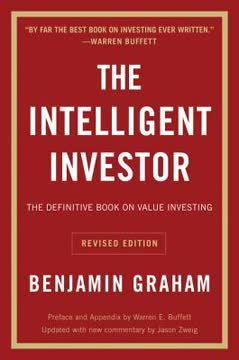
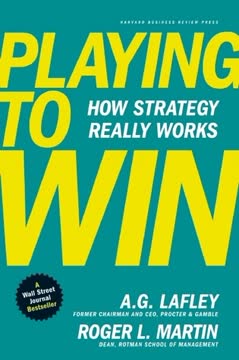
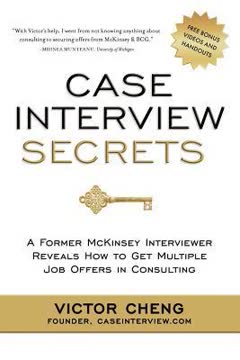
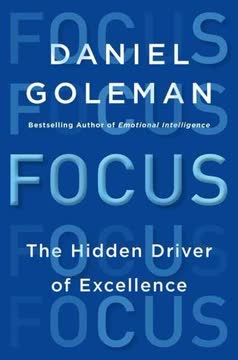
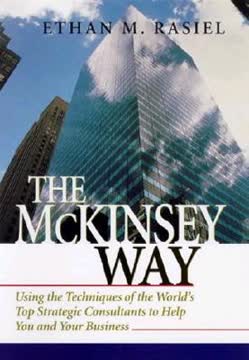
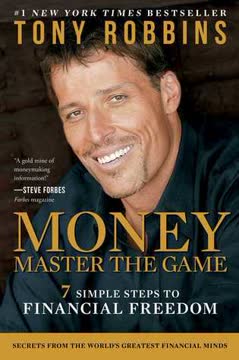
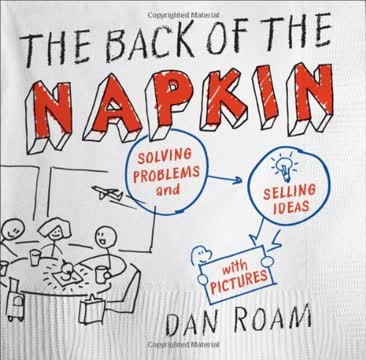


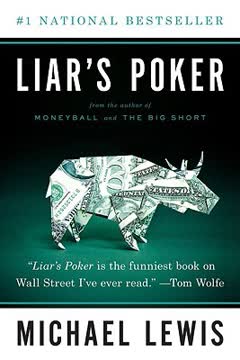
Download PDF
Download EPUB
.epub digital book format is ideal for reading ebooks on phones, tablets, and e-readers.
